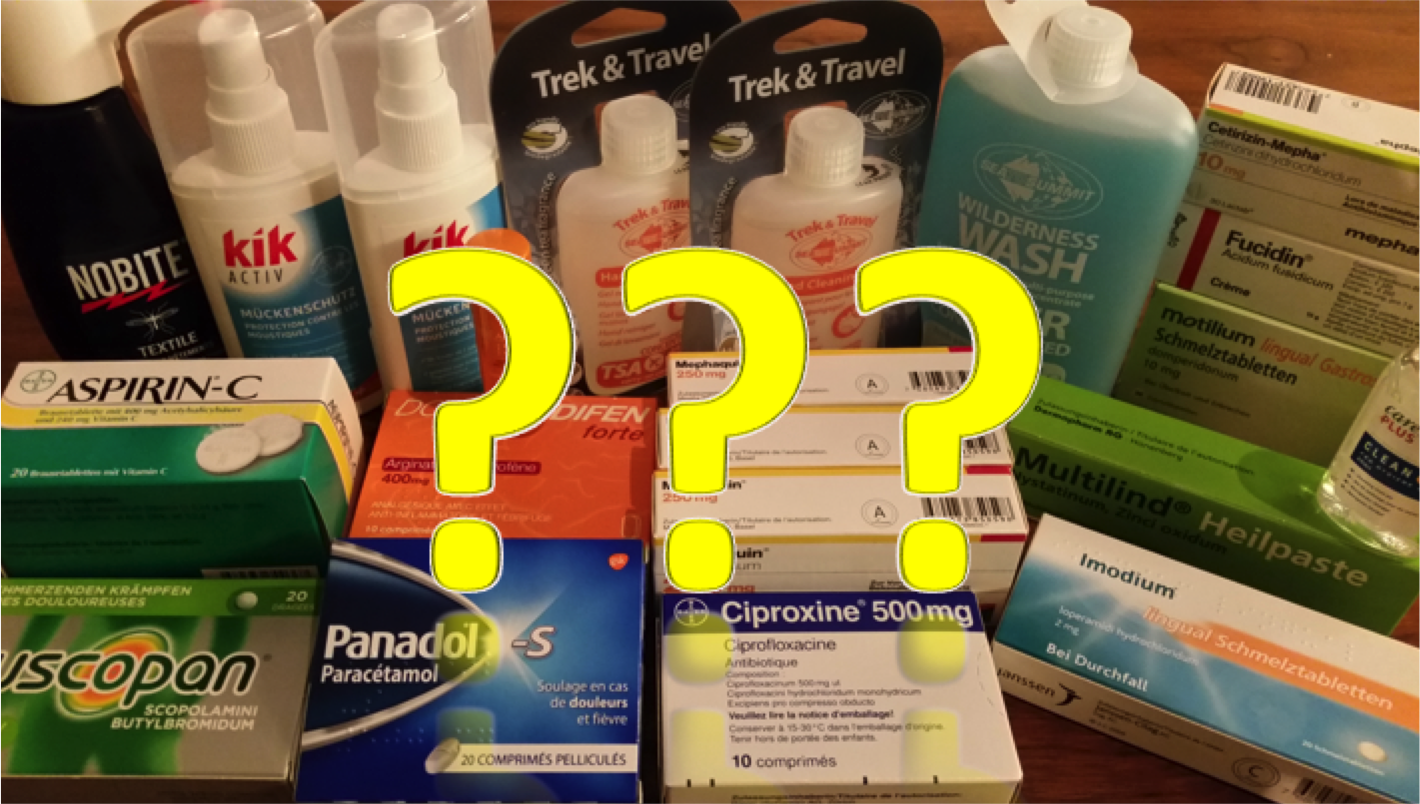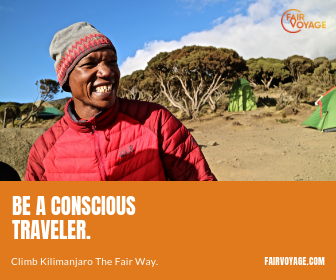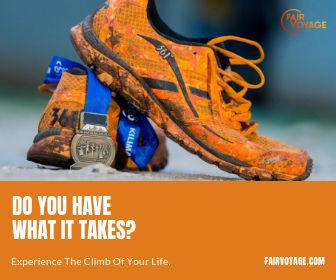When climbing Mount Kilimanjaro, safety should always come first, because let’s be honest – there have been some recorded deaths on Kilimanjaro. And so, of course, that also includes the right medical preparations and packing a bulletproof medical kit for your Kilimanjaro climb. Please make sure to consult your specialist doctor for expert medical advice.

Highly Recommended For Your Medical Kit For Kilimanjaro
Based on my assessment and experience for my own purposes, I would always bring or take the following for my next Kilimanjaro climb:
1. Antimalarial medication
Taking antimalarial medication is a must. The type of malaria in Tanzania may end lethal, even with appropriate post-infection treatment. For short trips, Malarone is generally prescribed as the standard medication because it has less side effects than other medications.
If you are on a tight budget, however, Lariam is a possible alternative. Other than being cheaper, it also has the benefit that you only need to take it once a week as opposed to daily for Malarone. However, side effects occur much more frequently for Lariam. They may be rather mild such as headaches and nausea—still not ideal while hiking a mountain—or, in more severe cases, lasting and potentially lethal side effects have been associated with Lariam. Run a quick search and you will find shocking examples, mostly related to mental illness and serious depression.
Having said that, it might work absolutely fine for you. The best would be to do a short test run before you leave so you could swap to Malarone if the side effects are too severe. According to my specialist doctor for tropical diseases, such severe side effects are usually associated with prolonged medication. They usually start with rather mild symptoms, such as nightmares. So, if monitored accordingly and discontinued in case of suspicious symptoms, the risk—in her opinion, but with a big legal disclaimer for you not to rely on my quotation—is rather low.
In my case, safety went before budget, and so I took Malarone for my two-week Tanzania vacation. However, I am currently planning a much longer four-month trip through Africa. Such prolonged stays in endemic areas not only make Malarone highly impractical (thinking of bringing a sufficient supply for daily medication), but also a financial fiasco. According to my specialist doctor, most people in such cases default to Lariama and—despite extreme exceptions—most people still handle it reasonably well. So I did a 4-week test run for Lariam and have not noticed any side effects. Based on that, I will take Lariam for my long trip, and I personally would also take it in my medical kit when climbing Kilimanjaro for my next shorter Kili climb.
For both Malarone and Lariam, please not that these are the common trade names for the substances atovaquone/proguanil and mefloquine. Cheaper generics might be available in your country at your time of reading.
2. Insect spray for your skin
Unfortunately, malaria is not the only mosquito-borne disease that you might contract while travelling in Tanzania. Dengue Fever is another such example, and—contrary to malaria—there is no preventative vaccination or medication against Dengue Fever. Nor can you get any vaccination or medication against Trypanosomiasis (Sleeping Sickness) which is transmitted by the endemic tsetse fly. So the best is to avoid getting bitten in the first place.
As someone who attracts mosquitoes and suffers from itchy swollen bites even if everyone else in my group barely notices the existence of mosquitoes, I have learnt my lesson: Only DEET containing insect spray effectively repels mosquitoes. Yes, DEET is poisonous and not good for you. But no, none of the other natural and healthier alternatives will do the trick. And believe me, I have tried them all!
Of course—overcareful as I was—I also made sure to bring insect spray onto Kilimanjaro for the lower altitudes on the first and last day. However, I can safely confirm what our guides had advised: No need to bring insect spray onto Kilimanjaro. Even at the lower altitudes, we were not bothered by mosquitoes.
Having said that, I got eaten alive while we had our pre-hike briefing in Moshi (though no one in our group seemed to have that problem). So yes, absolutely bring DEET containing insect spray to Tanzania and pack it in your medical kit when preparing to climb Kilimanjaro. Or make sure to always stay close to someone like me, though that might be less practical.
3. Insect spray for your gear
Insect spray containing permethrin is highly effective to repel mosquitoes when sprayed on your gear and clothes. Now, are you wondering why you need two different insect sprays for your gear and skin? Here’s why: DEET may damage materials. Some people use it nevertheless for their gear and, for several materials, it’s indeed not a big problem. However, proper hiking gear is often made of sensitive high-quality fabric. If you have invested a decent amount of money into functional gear, it would be a shame to ruin it with your insect spray. With permethrin, you need not worry about damaging your materials. Furthermore, the benefit of permethrin over DEET is that it’s less poisonous for your body. Unfortunately, however, it won’t work when directly applied to skin because the oils in our skin deactivate its effective substance.
Again, there’s no need to bring any insect spray onto Kilimanjaro. You can even pre-spray your gear at home. However, I still found having a bottle of permethrin insect spray useful in hotel rooms to spray bed sheets and mosquito nets (better for your lungs than DEET).
4. Pain killers
Of course, we all hope that we won’t need them, but headaches are so common on Kilimanjaro that pain killers should be part of every Kilimanjaro medical kit. Unfortunately, the debate of which pain killers are best is less clear cut and highly confusing—Aspirin, Ibuprofen or Paracetamol?
Aspirin and Ibuprofen are generally not recommended in endemic areas of dengue fever, which applies to Tanzania. The issue is that dengue fever is usually mistaken for a common fever or cold initially. When taking blood-thinning medication such as Aspirin or Ibuprofen, it may lead to severe excessive bleeding which could end potentially lethal.
Here’s the confusing part: wikitravel states that only Aspirin should never be taken when dengue fever is a possibility, while Ibuprofen is said to be safe. Furthermore, several Kilimanjaro resources recommend Ibuprofen for altitude-induced headaches. However, note that reputable sources of health advice such as the WHO clearly advise against taking both Aspirin and Ibuprofen in endemic areas of dengue fever.
So then isn’t Paracetamol the clear default pain killer for Kilimanjaro? Yes, but: Paracetamol may reduce the effectiveness of Malarone, i.e. potentially increases the risk of malaria infection.
So which one is the worse evil?
My specialist doctor suggested that taking Paracetamol only a few instances during a prolonged intake of Malarone wouldn’t impair the effectiveness of Malarone, so I need not worry about malaria. Thus, because it is the only pain killer that doesn’t increase the risk of dengue fever, I personally would conclude that Paracetamol is the best choice. Having said that, take note of Paracetamol’s potential interaction with Malarone and don’t overdose on it. If you take it every single day, it may well reduce the effectiveness of Malarone.
5. Vitamin C
Climbing Kilimanjaro will strain your immune system. The combination of physical exertion, cold wind and freezing night-time temperatures make it easy to catch a cold. Combine this with the lack of fresh fruits and vegetables compared to what you might be used to, especially if you chose a low-budget operator, and your odds of falling sick are probably higher than your odds of staying fit and healthy throughout. In order to boost your immune system and prevent potential colds, a daily vitamin C supplement may go a long way to help you enjoy your trip from beginning to end.
For those who read my book, you will know that—contrary to what I write above for pain killers—I took a daily dose of Aspirin+C as preventative cold remedy while climbing Kilimanjaro. For whatever reason, Aspirin+C is such a common cold remedy in the German-speaking world that the possibility of taking vitamin C without Aspirin didn’t even occur to me. I also considered the risk of having contracted dengue fever beforehand as sufficiently low in my case. My Aspirin+C shots certainly did the trick and helped me stay healthy and fit throughout my climb. However, in hindsight, as simple dose of vitamin C might have been the smarter choice for your medical kit when climbing Kilimanjaro.
6. Calcium/Magnesium compound
Similarly to vitamin C as cold prevention, a daily dose of calcium and magnesium may go a long way to prevent muscle cramps or sore muscles after a long day of walking. I put flavored effervescent tablets with a compound of calcium, magnesium and vitamin D into my water bladder to mix with my daily water supply. You could also use electrolyte compounds that further support your hydration which—other than going slowly—is so important for altitude acclimatization.
Using flavored tablets has the added side benefit to overpower any bad taste of your water. In our case, this turned out to be unnecessary as our water tasted clear throughout our climb. However, it perhaps depends on your operator as I had read different reviews from prior hikers.
7. Anti-diarrhea medication
Traveler’s diarrhea is one of those nasty ailments that we all hope to be spared when out in the wild, but it happens nevertheless—even with with best operators. What a nightmare, especially when stuck on a mountain without access to clean flush toilets! However, there’s an easy way to clog yourself up and avoid bowel movements when it would be most inconvenient: anti-diarrhea drugs. The most common drug is Loperamide—mostly sold under the trade name Imodium—which would be highly recommendable as part of your medical kit not only for Kilimanjaro, but all travels to developing countries.
8. Hand Sanitizer
To reduce the odds of contracting diarrhea, make sure to carry hand sanitizer and use it frequently—at least every time after using a toilet (or mother nature), and always before eating. Hand sanitizers come in small sizes, and usually a few drops is all you need to wash your hands.
9. Plasters for random cuts
It is easy to cut oneself, or for your skin—especially on your hands—to crack open due to the exposure to dry air and wind while climbing Kilimanjaro. To make sure a small cut stays a small cut and doesn’t become a big deal—blood poisoning being one of the most under-estimated causes of death—carrying a few plasters should be a no-brainer.
10. Blister plasters or moleskin
I can’t re-iterate often enough the importance of getting professional advice when buying your hiking boots. A well-fitting pair of boots should not cause blisters from the start. However, sadly enough, blisters are a common occurrence on Kilimanjaro. Of course, not everyone has the chance to consult an expert for buying their boots, or you might even just borrow your boots for Kilimanjaro (not advisable). Unless your boots fit you perfectly, you are almost guaranteed to get blisters. So make sure to bring a sufficient stock of moleskin or special blister plasters.
Optional Items For Your Medical Kit For Kilimanjaro
Other than the items above, you might also want to consider the following:
1. Antiemetic and sore throat medication
An antiemetic is a drug against vomiting and nausea—both common symptoms of altitude sickness. Not directly related, you might get a sore throat from the constant exposure to cold air and the climb’s strain on your immune system. The reason I group these two distinct conditions under one is that you can use one and the same remedy for both vomiting/nausea and a sore throat: ginger lozenges. They are purely natural without side effects, and taste pretty good. So even if you don’t feel sick, you might still enjoy them. Of course, there is also stronger medication available for both symptoms, which you might want to consider additionally.
2. Antibacterial ointment / topical antibiotics
I had seen this item on some other kit lists, and so—keen to err on the safe side—I made sure to carry a topical antibiotic ointment onto Mount Kilimanjaro. In hindsight, I think this was over the top. For my next Kilimanjaro climb, I would not bring a special antibacterial ointment, but just use hand sanitizer for smaller cuts and wounds, as also my tropical disease doctor suggested that most travelers do.
3. Anti-constipation medication
It may sound counter-intuitive because diarrhea is more commonly associated with Kilimanjaro. However, I would argue that constipation is probably the more frequent problem, though certainly less problematic. Nevertheless, with limited fiber intake and no toilet privacy, constipation might cause you some stomach pain if you can’t get your bowels to move over several consecutive days.
I had tried Dulcolax (Bisacodyl) before, and it worked like a charm. Should you need it on Kilimanjaro, I would recommend to take it in the afternoon when you arrive at your camp. Don’t worry, it won’t cause you problems during your next day’s hike nor give you diarrhea. It simply eases the flow and should be effective by the next morning at the latest so don’t forget to include it in your medical kit when climbing Kilimanjaro.
4. Diamox
If you haven’t come across it yet—but you certainly will—Diamox is a drug commonly used to prevent and treat altitude sickness. It is so frequently mentioned and recommended in Kilimanjaro literature and blogs that you might be surprised I list Diamox last. Well—according to my humble opinion—Diamox is the most overrated drug used on Kilimanjaro. I have yet to see summit success statistics comparing hikers who took Diamox with those who didn’t. However, statistics are very clear on the real number one summit success factor: number of hiking days prior to your summit attempt. This is because the best way to prevent altitude sickness is to acclimatize slowly.
After much reading, I concluded that the side effects of Diamox on a week-long hike may be more detrimental to our summit success and wellbeing than beneficial. This is because Diamox causes frequent urination, which again means you won’t get any good night sleep. If you are used to sleeping through the night, but because of Diamox you will have bad sleep for consecutive days before you attempt the final summit push, guess what this does to your emotional and physical condition!? I’d really love to see some thorough statistics on that to validate this argument. Unfortunately, I’m not aware of any such data. So, for now, this is just my personal assumption which you can choose to believe or not.
However, I do understand that there are valid reasons why hikers continue to opt for shorter routes. If your reason is to minimize your days without shower, that’s not what I mean. Please don’t let your fear of being out in the wild for too long ruin your summit success chances. No one could possibly be more freaked about not showering for multiple days than I was. In hindsight, I not only survived nine days in the wild without any problems, but even enjoyed every single day.
By valid reasons, I mean serious constraints on time or money. If you really need to cut it short, than Diamox might help you reach the summit. However, please make sure to familiarize yourself with all its side effects, as well as what it can and cannot do. If used incorrectly, it might do more harm than good.
5. Other
The above items are not meant to be exhaustive. Of course, make sure to bring any prescription drugs. Women might want to take contraceptive pills to prevent their menstrual cycle from coming due at a most inconvenient time. Operators also frequently recommend standard first aid kit components such as a gauze, alcohol wipes and adhesive tape for your medical kit when climbing Kilimanjaro. Finally, should you travel via an endemic country of yellow fever, you will need to obtain vaccination beforehand and show your vaccination certificate when entering Tanzania.
For a complete gear and packing kit list, please click here.
















Leave a Reply
You must be logged in to post a comment.